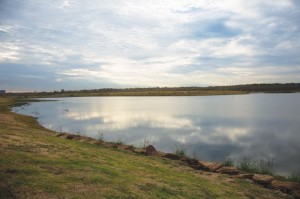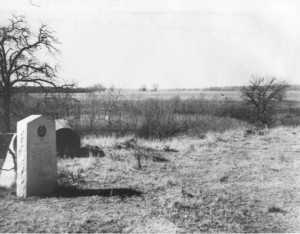
Sahlstein walked to a clearing near a tree on a section of privately owned land inside the Viridian development. He described the tranquil area located near the Archosaur site as a sacred place.
“I like seeing the end of the era of this being the Wild West,” he said. “This is beautiful down here now.”
This is where Sahlstein goes to pray, but he’s not the first to find peace here.
On Sept. 29, 1843, according to the Texas State Archives Commission, a peace treaty between the Republic of Texas and 10 Native American tribes was established and signed here. The area was once home to Bird’s Fort, named after Major Jonathan Bird. According to Arlington, Texas: Birthplace of the Metroplex by Arista Joyner, Bird had scouted for Indians, led an unsuccessful encounter with Indians at Village Creek, and built the fort.
In 1844 at Washington-on-the-Brazos, the treaty was signed by Sam Houston, an adopted Cherokee and president of the Republic of Texas.

A large granite Bird’s Fort historical marker, placed there to honor the Texas Sesquicentennial, was removed after being damaged by vandals who were using it as target practice, Sahlstein said. The monument now rests under a camper top at a nearby business.
In his book Caddos, Cotton and Cowboys, former Arlington Citizen-Journal publisher and editor O.K. Carter wrote that when Texas became the 28th state, all previous treaties signed by the nation of Texas, whether with Indians or other nations, became void. “Indians in the area — those that cooperated, at least — were first relocated to Young County, near Graham, about 100 miles west, and eventually from there to Oklahoma in the 1860s.”
In other words, the treaty became worth no more than the paper it was written on after Texas teamed up with the United States. Today, four Native American tribes are recognized by the federal or state government in Texas. None of the 10 tribes that signed Bird’s Fort Treaty are among them.
Geraldine Mills, director of the Arlington Historical Society, said the attempted settlement at Bird’s Fort preceded the Anglo settlements in Dallas and Fort Worth. She also said the land at Bird’s Fort probably looked good at first to the group of people who tried settling there. It was near water and offered plenty of wood for fuel and homebuilding.
One thing that was not considered, however, was the climate.
“It flooded, and it was mosquito ridden, and they [figuratively] froze to death,” she said. “They finally got smart and went on down the river and founded Dallas.”
Arlington Historical Society board member Steve Barnes said another problem the people at the fort encountered was that the land had already been granted to the Peters Colony.
Barnes said Houston had visited the fort “to make things good with the Indians,” but the tribesmen, who were a bit skittish, stood him up. Houston waited, but mosquitoes sent him packing, and he went on to camp at Grapevine Springs, Barnes said. Houston left to handle other business before the treaty was signed, and E.H. Tarrant and G.W. Terrell are listed among the signing’s witnesses.
“Because of the Bird’s Fort Treaty, the Republic of Texas continued their push to establish a line of trading houses,” he said.
Barnes explained how prior to the Bird’s Fort Treaty, the original trading house that was supposed to have been established in the area had stopped near Waco, leaving a wide gap between the Brazos and the Red rivers.
Barnes said that because of the treaty, a trading house could not be opened east of the established line. Isaac Spence settled trading house No. 1 at what was known as Marrow Bone Springs, right near present day Arkansas Lane.
“The west was for the Indians,” Barnes said. “The east was for the white man. If you wanted to deal with one or the other, you came to the trading house.”
Barnes said from what he has gathered, John Neely Bryan originally wanted to open a trading house at his location, in what is now Dallas, but he couldn’t because of the treaty.
“So he starts a town,” he said. “Then you’ve got the roots of Dallas going.”
Barnes then produced a copy of a 1936 Dallas Morning News article stating that after the original Bird’s Fort Treaty was discovered in Austin, the debate about where Bird’s Fort Treaty had been signed was laid to rest. Up until then, it had been contended that the treaty was signed in Dallas County rather than Tarrant. It was Tarrant.
Barnes said Bird’s Fort is also where one of the earliest Anglo burials in the area took place. One burial that took place, Joyner wrote, was that of a man named Hamp Rattan who had been killed by Indians and whose body was guarded for days by his faithful dog “Watch” until it was finally recovered.
******












An archaeologist is not a paleontologist. Paleontologists deal with dinosaurs and fossils, not archaeologists.